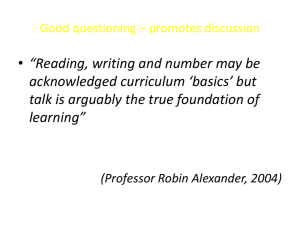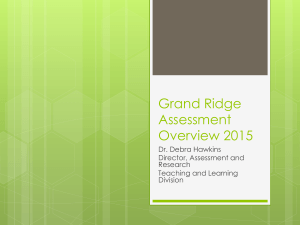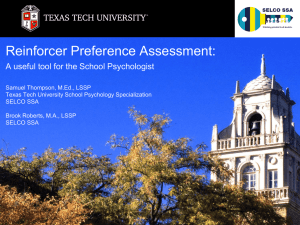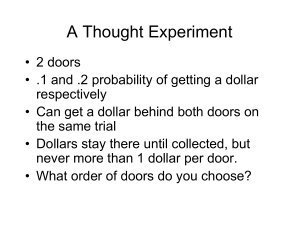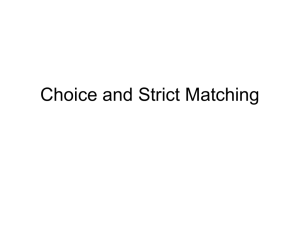Identifying reinforcers can be difficult
advertisement
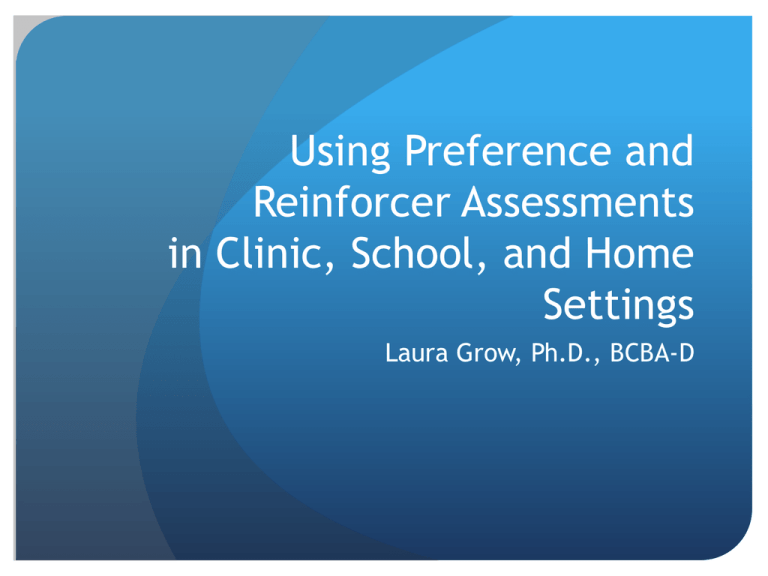
Using Preference and Reinforcer Assessments in Clinic, School, and Home Settings Laura Grow, Ph.D., BCBA-D Reinforcer Identification Reinforcers are identified for: Skill acquisition programs (e.g., communication) Behaviour reduction programs (e.g., environmental enrichment) Common types of programmed reinforcers Toys Edibles Activities Praise Methods Used to Identify Reinforcers Indirect assessments RAISD (Fisher, Piazza, Bowman, & Amari, 1996) The assessment is not sufficient but should be used with other assessments Preference assessments The purpose is to identify hierarchy of preferred items The items may or may not function as reinforcers for behaviour Reinforcer assessments The purpose is to determine if the items function as reinforcers Typically includes items identified from a preference assessment Preference Assessments in Practice Approximately 65% of early intervention programs use daily preference assessments with the clients (Love, Carr, Almason, & Petursdottir, 2009) Research shows that preferences shift over time (Hanley, Iwata, & Roscoe, 2006) Daily preference assessments identify reinforcers more reliably than one-time assessments (DeLeon et al., 2001) Practical Considerations Identifying reinforcers can be difficult: Individuals might have limited verbal repertoires Individuals might not be naturally exposed to a variety of reinforcers Preferences are idiosyncratic Preferences change over time Mixing primary and conditioned reinforcers can confound the results Types of Preference Assessments Approach-based assessments Single-stimulus assessment (Pace et al., 1985) Multiple stimulus with/without replacement (DeLeon & Iwata, 1996) Paired-choice assessment (Fisher et al., 1992) Duration-based assessments Single stimulus engagement procedure (Hagopian, Rush, Lewin, & Long, 2001) Free-operant assessment (Roane et al., 1998) Single-Stimulus Preference Assessment First systematic assessment based on direct observation (Pace et al., 1985) Present the individual with items one at a time Record how the individual interacts with each item Rank the items based on the percentage of trials in which the items was consumed Considerations Individuals may select items indiscriminately Assessment may be useful for individuals that cannot select among more than one option Multiple Stimulus Assessments • Client is presented with multiple (e.g., 8) stimuli and allowed to select one at a time • Several arrays can be implemented • With replacement (MSW) – chosen item is replaced in the array • Without replacement (MSWO) – chosen item is not replaced (DeLeon & Iwata, 1996) • About as effective with the paired-stimulus method, but briefer • Use when preference for multiple stimuli needs to be assessed quickly Multiple Stimulus Assessments Brief MSWO (Carr, Nicolson, & Higbee, 2001; Paramore & Higbee, 2005) Utilized three arrays instead of the five used in DeLeon & Iwata, 1996 Used the assessment in natural contexts with children and adolescents May be more practical in educational settings where extended assessments are not feasible Carr, Nicolson, & Higbee, 2001 Paired-choice Preference Assessment The individual is presented with pairs of items Counterbalance the presentation of the items to evaluate side biases Record the selected item for each trial Rank based on the percentage of trials in which the item was selected Considerations Lengthy Individual must be able to select from a pair of items If you have 5 stimuli: (1) S1 – S2 (6) S4 – S1 (2) S3 – S4 (7) S3 – S5 (3) S5 – S1 (8) S2 – S4 (4) S2 – S3 (9) S4 – S5 (5) S1 - S3 (10)S5 – S2 Free Operant Assessment • Based on study conducted by Roane and colleagues (1998) • Present the individual with an array of items • Allow the individuals to freely interact with any of the items for a period of time • Record the duration of engagement for each item • Rank the items based on the percentage of engagement Free Operant Assessment • Considerations • Useful when a few high-preference stimuli need to be quickly assessed or when concerned about problem behavior • Might only identify 1 or 2 items • Can also record problem behavior concurrently with item interaction • Competing items assessment Roane et al. (1998) Single-Stimulus Engagement Assessment Present the individual with items one at a time Record how the duration of engagement with each item Rank the items based on the duration (or percentage) of engagement Considerations Useful for individuals that cannot select among more than one option Useful for activities/items that are not easily presented in a choice/ table-top fashion Hagopian, Rush, Lewin, & Long, 2001) **Table is taken from Karsten, Carr, Lepper (2011) Common Problems and Possible Solutions Large items/activities Pictures of the items/activities Verbal descriptions of the items/activities Must arrange immediate access to the selected item/activity Individual has a positional bias Paired-choice and MSWO can help identify a bias Single-stimulus presentations circumvent the bias Alternative presentations may reduce/avoid the bias Developing a Model for Conducting Preference Assessments Karsten, Carr, & Lepper (2011) Developed a practitioner model for conducting comprehensive preference assessments Included a decision-making tree to assist practitioners with selecting appropriate assessments and addressing issues that might arise Reinforcer Assessments Published reinforcer assessments often include relatively simple tasks with dense schedules of reinforcement What about larger work requirements or more difficult tasks? Instructors might consider using progressive-ratio assessments to evaluate reinforcer strength Progressive-ratio Analysis The schedule requirement to access reinforcers is increased within a single session FR1, FR3, FR5, and so on Instructor collects data on the last schedule requirement completed by the learner (i.e., break point) Break points can serve as an index of reinforcer strength DeLeon, Frank, Gregory, & Allman, 2009 Conclusions Direct observations of preference are more reliable than caregiver/teacher report Methods can and should be conducted frequently Avoid mixing categories of reinforcers (e.g., food and toys) Consider alternative formats Pictorial Verbal Variations on the array presentation Conclusions Conduct a comprehensive preference assessment initially Conduct brief assessments on a daily or hourly basis Consider using 1-array MSWOs Consider using brief free operant assessments




